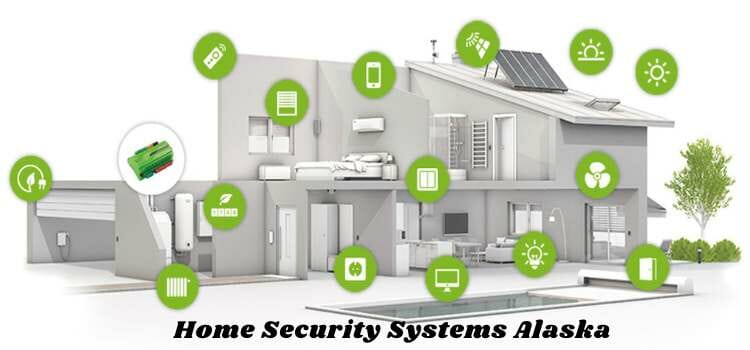The latest technology in home security systems
Introduction:
In today’s digital age, home security is more important than ever. With the rise of smart technology, home security systems have evolved to provide homeowners with a sense of safety and security. Gone are the days of traditional alarm systems and security cameras that are limited in their functionality. The latest technology in home security systems has transformed the way we approach home protection, offering advanced features, increased connectivity, and enhanced monitoring capabilities.
From smart doorbells to AI-powered surveillance systems, the latest advancements in home security technology are designed to provide homeowners with peace of mind. With the ability to monitor and control your home security system remotely, you can stay connected to your home and loved ones like never before. But what exactly does this new technology entail? And how can it benefit your home and family? In this blog, we’ll explore the latest developments in home security systems, highlighting the most innovative features and benefits that can help you stay ahead of the game when it comes to keeping your home safe and secure.
Here are four potential subheadings for a blog post on “The Latest Technology in Home Security Systems”:
1. Smart Cameras and Surveillance: The Future of Home Monitoring
Smart cameras and surveillance systems have become a crucial component of home security, providing homeowners with a sense of safety and security. With the rise of smart technology, these systems have evolved significantly, offering advanced features and capabilities that make them an essential part of modern home security.
One of the key advantages of smart cameras is their ability to detect motion and alert homeowners to potential threats. These cameras use advanced sensors and software to detect even the slightest movements, sending alerts to homeowners’ mobile devices in real-time. This allows homeowners to respond quickly and effectively to any potential threats, minimizing the risk of damage or harm.
Another significant benefit of smart cameras is their ability to provide real-time video feed. This allows homeowners to monitor their homes remotely, using their smartphones or tablets to check in on their property at any time. This feature is particularly useful for homeowners who are away from their property for extended periods, as it provides them with peace of mind and reassurance.
In addition to their ability to detect motion and provide real-time video feed, smart cameras also offer cloud storage. This means that footage can be stored securely in the cloud, allowing homeowners to access it at any time and review it if necessary. This feature is particularly useful for homeowners who need to investigate an incident or provide evidence to law enforcement.
Smart cameras are also highly integrated with other smart devices, making it easy to control and monitor multiple devices from a single interface. For example, some smart cameras can be integrated with smart doorbells, allowing homeowners to view visitors at the door from their smartphone. Others can be integrated with smart lighting systems, automatically adjusting lighting levels based on motion detection.
As smart cameras continue to evolve, we can expect to see even more innovative features and capabilities. One of the most exciting developments is the integration of artificial intelligence (AI) into smart cameras. This will allow them to recognize specific objects, such as people or pets, and alert homeowners accordingly. Another development is the integration of facial recognition technology, which will enable smart cameras to recognize specific individuals and alert homeowners if they are detected.
In conclusion, smart cameras and surveillance systems have revolutionized the way we approach home security. With their advanced features and capabilities, they offer a reliable and effective way to monitor our homes and loved ones. As technology continues to evolve, we can expect even more exciting developments in the world of smart cameras. Whether you’re looking for a simple, affordable solution or a comprehensive, high-end system, smart cameras have something to offer.
2. Biometric Authentication and Advanced Locks: Securing Your Home Like Never Before
In today’s digital age, home security is more important than ever. With the rise of smart technology, home security systems have evolved to provide homeowners with a sense of safety and security. One of the most innovative advancements in home security is the integration of biometric authentication and advanced locks. These cutting-edge technologies have revolutionized the way we secure our homes, providing unparalleled levels of security and convenience.
Biometric authentication is a technology that uses unique physical or behavioral characteristics to identify individuals. In the context of home security, biometric authentication can be used to unlock doors, grant access to specific areas, or even monitor who’s entering your home. This technology is particularly effective because it eliminates the need for passwords or keys, which can be easily lost, stolen, or forgotten.
Advanced locks are another key component of modern home security. These locks are designed to provide maximum security and flexibility, with features such as smart keypads, touchless entry, and remote monitoring. Some advanced locks can even integrate with other smart devices, allowing you to control them remotely through your smartphone.
One of the most impressive features of advanced locks is their ability to detect and respond to potential threats. For example, some locks can detect unusual patterns of activity, such as someone trying to pick the lock or attempting to force entry. In these situations, the lock can alert you and the authorities, providing an added layer of protection.
Another significant benefit of advanced locks is their ability to integrate with other smart devices in your home. For example, you can program your lights to turn off when you enter your home, or have your thermostat adjust to your preferred temperature. This level of integration provides unparalleled convenience and control over your home.
In addition to their advanced features, biometric authentication and advanced locks are also highly secure. They use advanced encryption protocols and secure communication channels to ensure that your data is protected from unauthorized access.
In conclusion, biometric authentication and advanced locks are two of the most innovative advancements in home security. These technologies provide unparalleled levels of security and convenience, making it easier than ever to secure your home like never before. Whether you’re looking for a simple way to secure your front door or a comprehensive solution for your entire home, biometric authentication and advanced locks are the perfect solution.
3. AI-Powered Home Security Systems: Predictive Analytics and Automated Response
The world of home security has undergone a significant transformation in recent years, with the integration of artificial intelligence (AI) technology into home security systems. AI-powered home security systems are revolutionizing the way we approach home security, providing unparalleled levels of protection and convenience. These systems use advanced algorithms and machine learning techniques to analyze data and predict potential threats, allowing for proactive and automated response.
One of the most significant benefits of AI-powered home security systems is their ability to predict potential threats. These systems use advanced analytics to analyze data from various sources, including sensors, cameras, and motion detectors. This data is then used to identify patterns and anomalies, allowing the system to predict potential threats before they occur. For example, if a system detects unusual activity at a specific time of day, it may alert the homeowner and authorities to take action.
Another key feature of AI-powered home security systems is their ability to automate response. Once a potential threat is detected, the system can automatically respond to minimize the risk. This may involve alerting the homeowner, contacting emergency services, or even activating a security device to deter the threat. For example, if a system detects an intruder attempting to enter a home, it may automatically trigger an alarm or send a notification to the homeowner’s phone.
AI-powered home security systems also offer enhanced video surveillance capabilities. These systems can analyze footage in real-time, using advanced algorithms to detect and track suspicious activity. This allows for more effective monitoring and response, as well as improved evidence gathering in the event of a crime.
In addition to predictive analytics and automated response, AI-powered home security systems also offer enhanced customer service. These systems can provide personalized recommendations and alerts based on individual behavior and preferences, allowing homeowners to tailor their security settings to their specific needs.
Some of the leading AI-powered home security systems on the market today include:
* Nest Secure: A comprehensive home security system that uses AI-powered analytics to detect and respond to potential threats.
* Ring Alarm: A smart doorbell system that uses AI-powered video analytics to detect and respond to suspicious activity.
* August Home: A smart lock system that uses AI-powered analytics to detect and respond to potential threats.
In conclusion, AI-powered home security systems are revolutionizing the way we approach home security. These systems use advanced analytics and machine learning techniques to predict potential threats and automate response, providing unparalleled levels of protection and convenience. With their ability to predict and respond to potential threats, AI-powered home security systems are an essential tool for homeowners looking to stay safe and secure in today’s digital age.
4. Wireless Connectivity and Remote Access: The Benefits of Seamless Home Security
The traditional approach to home security has been limited to wired systems, which can be cumbersome and restrictive. However, with the advancement of wireless technology, home security systems have become more convenient and accessible than ever before. Wireless connectivity and remote access have transformed the way we secure our homes, providing unparalleled levels of convenience, flexibility, and peace of mind.
One of the primary benefits of wireless connectivity is the ability to access and control your home security system remotely. With a smartphone or tablet, you can check the status of your security system, receive notifications, and even arm or disarm it from anywhere in the world. This level of convenience is especially important for individuals who are away from home frequently, such as business travelers or those who live in remote areas.
Wireless connectivity also enables seamless communication between different devices and systems within your home. For example, you can integrate your security system with your smart door locks, lights, and thermostat, creating a comprehensive smart home ecosystem. This integration allows for automatic responses to specific events, such as locking your doors when you leave the house or turning off lights when you go to bed.
Another significant advantage of wireless connectivity is the ability to add devices and sensors to your system as needed. Without the need for wiring or complicated installation processes, you can easily add new devices or sensors to expand your system’s coverage and capabilities.
Remote access is another crucial aspect of wireless connectivity. With remote access, you can monitor your home’s security status in real-time, even when you’re not physically present. This allows you to respond quickly to potential threats or issues, ensuring that your home remains safe and secure.
In addition to these benefits, wireless connectivity and remote access also provide enhanced security features. For example, some systems offer advanced encryption protocols to ensure that your data is protected from unauthorized access. Additionally, many systems offer automatic software updates, ensuring that your system remains secure and up-to-date.
In conclusion, wireless connectivity and remote access have revolutionized the way we approach home security. By providing seamless communication between devices and systems, easy expansion and integration options, and enhanced security features, wireless connectivity has transformed the home security landscape. With the ability to monitor and control your home security system from anywhere in the world, you can enjoy unparalleled levels of peace of mind and security.
Conclusion:
In conclusion, the latest technology in home security systems has transformed the way we approach home security. With advancements in AI-powered analytics, wireless connectivity, and remote access, home security systems have become more efficient, convenient, and effective. From predictive analytics to automated response, these systems have taken the guesswork out of home security, providing unparalleled levels of protection and peace of mind.
As technology continues to evolve, we can expect even more innovative solutions to emerge in the world of home security. From voice-controlled systems to smart home integration, the future of home security is bright and exciting. With the constant threat of intruders and cyber attacks, it’s essential to stay ahead of the curve and invest in a home security system that can keep up with the demands of modern life.
Whether you’re a homeowner looking for a reliable and effective way to protect your property or a business owner seeking to secure your premises, there’s never been a better time to invest in a state-of-the-art home security system. With the latest technology at your fingertips, you can enjoy the freedom and security that comes with knowing your home and loved ones are safe and protected.



